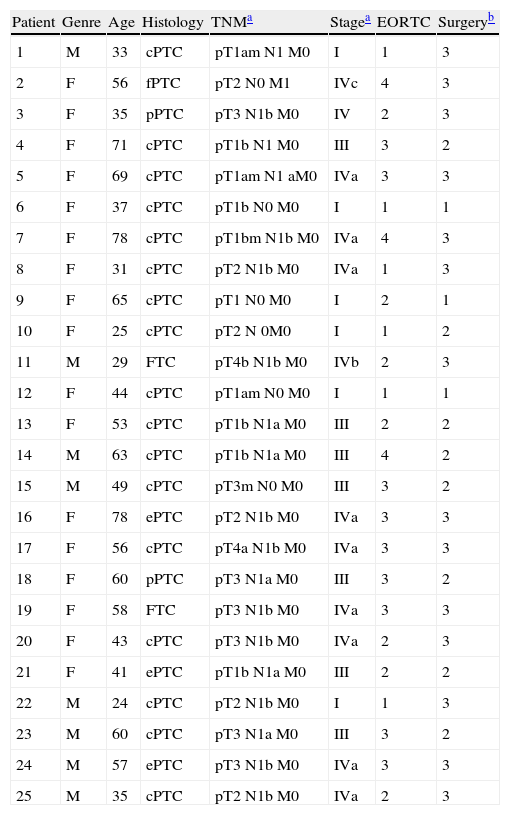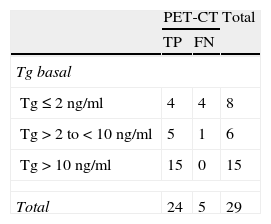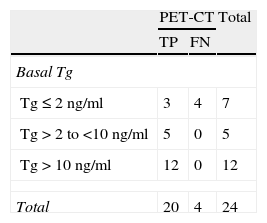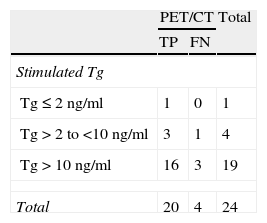To assess the diagnostic performance of 18F-FDG PET-CT scan and its relation to serum thyroglobulin (Tg) levels in patients with differentiated thyroid carcinoma with suspicion of persistence or recurrence of the disease and negative radioiodine scans.
Material and methodsThis is a retrospective analysis of 35 PET-CT studies in 25 patients (17 women, average age 48.8±15.2 years). The results were confirmed by histology or by ultrasonography and clinical follow-up. We analyzed the relationship between the diagnostic performance of the PET-CT scans and three levels of Tg: less than or equal to 2ng/ml; between 2 and 10ng/ml and greater than 10ng/ml.
ResultsWe obtained 26 true-positives (TP), 1 false-positive (FP), 3 true-negatives (TN) and 5 false-negatives (FN). Of the 18 patients with PET-CTs classified as TP, 3 showed lesions at the post-thyroidectomy bed, 15 showed lymph node metastases and 5 had distant metastases. Sensitivity was 83.9% (CI 95%: 69.3–98.4%) and specificity was 75% (CI 95%: 20–100%).
Regarding the three intervals of Tg, PET-CT scan showed true positive rates of 37.5%, 83% and 100% in patients with Tg levels of less than 2ng/ml, between 2 and 10ng/ml and more than 10ng/ml, respectively.
Conclusions18F-FDG PET-CT demonstrates high diagnostic yield in local disease and distant lesions for the population of patients with differentiated thyroid carcinoma and persistence of the disease with negative radioiodine scans at Tg levels above 2ng/ml.
Evaluar el rendimiento diagnóstico de la PET-TC con 18F-FDG y su relación con los niveles séricos de tiroglobulina (Tg) en los pacientes con cáncer diferenciado de tiroides con sospecha de persistencia o recurrencia de enfermedad y rastreo con radioyodo negativo.
Material y métodosAnálisis retrospectivo de 35 estudios PET-TC en 25 pacientes (17 mujeres, edad media 48,8±15,2 años). Los resultados se comprobaron histológicamente, o mediante ecografía y seguimiento clínico. Se analizó la relación entre el rendimiento diagnóstico de la PET-TC y tres niveles de Tg: menor o igual a 2ng/ml; entre 2 y 10ng/ml y mayor a 10ng/ml.
ResultadosSe obtuvieron 26 verdaderos positivos, un falso positivo, tres verdaderos negativos y cinco falsos negativos. De los 18 pacientes con una PET-TC clasificada como VP, tres mostraron lesiones en el lecho post-tiroidectomía, 15 mostraron afectación ganglionar y cinco presentaron metástasis a distancia. La sensibilidad fue del 83,9% (IC 95%: 69,3-98,4%) y la especificidad del 75% (IC 95%: 20-100%).
Para tres intervalos de Tg, la PET-TC mostró una tasa de verdaderos positivos del 37,5%, 83% y 100% en los pacientes con niveles de Tg < 2, entre 2-10 y > 10ng/ml, respectivamente.
ConclusionesLa PET-TC con 18F-FDG muestra un alto rendimiento diagnóstico de la enfermedad loco-regional y a distancia en la población de pacientes con cáncer diferenciado de tiroides en situación de persistencia de enfermedad y rastreo con yodo negativo con niveles de Tg por encima de 2ng/ml.
Artículo

Revista Española de Medicina Nuclear e Imagen Molecular (English Edition)
Comprando el artículo el PDF del mismo podrá ser descargado
Precio 19,34 €
Comprar ahora










